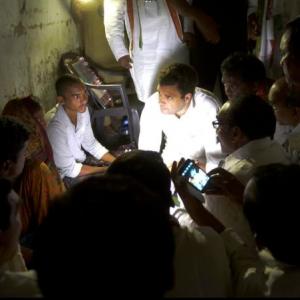The temptation to rehash Manmohanomics is not going to deliver the achche-din that Narendra Modi has promised, warns Sriram Balasubramanian.

The recent race related incidents in the United States in Ferguson and Baltimore have made us ponder even more about the effects of modern day capitalism. Besides the race angle in the US, which is gaining traction, the underlining theme that resonates is the inequality that is rampant in the developed and developing countries. With Narendra Modi completing a year at the helm, it is an appropriate time to see the impact on a more rapidly globalising India and whether we are at risk on the social inequalities of the day here.
To understand the broader scenario, one needs to first understand the background of these riots in the US and why they resonate a particular trend that is growing in the world. While people might argue that these riots are a direct result of police atrocities towards minorities, that just the tip of the iceberg. Besides being a minority, African-Americans are one of the most underprivileged sections of people in the US. In essence, they belong to the lowest part of the inequality spectrum and are affected the most. This means lower opportunities for jobs, education and many other normal services that other communities are privileged towards. More than race, the riots are also an indictment on the vast amount of inequality that is seeping through the countries which are engulfed in financial capitalism, i.e the wealthy 1 per cent versus the rest.
The advent of capitalism in India over the last decades has resulted in significant growth and wealth creation. No doubt it has boosted the economic performance of the states and has uplifted certain sections of people towards more economic prosperity which is material in nature. This prosperity has been urban centric in nature and has been a confluence of economic policies that have originated from the West. Even though the amount of FDI in India is just over 1.4 per cent, the impact of opening up of the economy has been significant.
However, it has also resulted in rampant inequality in various sections of the society. Within the urban conglomerate’s, growth of inequality has been rampant. Excessive focus on services has resulted in lack of focus on agriculture, which contributes to about 20 per cent of GDP, yet has 60 per cent of the Indian workforce. Since the capital centric model has not been customised to India’s multicultural and multi-diverse ethnicity, there is a chance that we could end up where the developed countries already are in the years to come.
A classic point in case is the farmers' agitation with regard to the Land Acquisition Bill. The fundamental issue in this, beside the dearth of communication by government’s machinery, is that the small farmer feels intimidated by corporate onslaught that is thrown at him. Agriculture is not thriving especially for small farmers and there is a socio-economic division happening within India between the farmers and the rest. While it has not produced riots that have been in the US and European countries, one wouldn’t be surprised if such things happen in India. Wouldn’t the farmer, who has been ignored perennially by the government, be left with no option but to protest? This inequality is not just pertaining to rural-urban divide, it extends way beyond that and this is why such incidents in the US could not be far away from happening in India also.
As per statistics from the World Bank, between 1994 and 2005, the income share held by the highest 10 per cent of the population increased from 26 per cent to 28.3 per cent while that of the bottom 20 per cent decreased from 9.09 per cent to 8.64 per cent. According to the OECD, between 1993 and 2008, India's Gini coefficient increased from 0.32 to 0.38. As per the recently released Human Development Report (HDR) 2014, India ranked 135th (134th in 2011) in Human Development Index (HDI). When the HDI is adjusted for inequality, the index loses its value by as much as 29.3 per cent and that should strike people in the know about economics. This particularly points to a trend which is similar to those that the US is going through now. Since we ape the Western model, though it should have been customised to India’s own needs, we are likely to face the same set of consequences.
Considering that there is significant unemployment among India's youth, wouldn’t it surprise you if frustration creeps in if these massive expectations are not met? Wouldn’t the inequality in urban cities, where there is significant unemployment, also lead to such revolts? Urban inequality is at an all time high and it is expected to be one of the most unequal developing countries by 2020. In such a scenario, unless India looks at inequality in a more concerted manner, we will end up with discontentment in both rural and urban pockets. Besides the economic impact, there is a large sociological impact that we have highly underestimated when the country was liberalised.
While the elite in the country was willing to embrace the economic benefits of liberalisation, it has completely failed to gauge the social consequences of a liberalised India. The multi-cultural fabric of India is its core asset; a civilisation that has spawned thousands of years and overcome many an obstacle. The social consequences of liberalisation have been the commoditisation of literally everything that one has to offer. According to a recent survey, the single most important barometer for success among the young is money. The social constructs that a non-capitalistic society adhered are being viewed with contempt by the younger generation with monetary growth being the single most driving factor for living.
While there is tremendous opportunity for us to use our culture as a soft power which generates global intellectual thought, we are clueless because of our subservience to anything that is market driven and our inadequacy in understanding our own cultural aesthetics with reason and appreciation. This is accentuated further by the inadequacy of the previous generation to deal with the social challenges of young India. The young are intelligent and restless with an overdose of information thrown at them. Rightly so, they are convinced by logic and the older generation needs to refresh their knowledge to adapt to the needs of the younger generation. A direct consequence of the social changes that are happening is the alienation of the older generation. India is set to become one of the world’s oldest populations in the next 30 years. According to the 2011 Census, senior citizens (aged 60 and above) accounted for 8.4 per cent of the population, an increase of one percentage point over 2001, meaning an addition of almost 27 million elderly people over the decade.
The total population of senior citizens is expected to increase to 320 million by 2050. In addition, the number of ageing people in some of the states is almost equivalent to the total number of elderly people in some Scandinavian countries. Add to this the Total Fertility Rate (TFR). Over nine states have a TFR of more than 2.1, which indicates an increase in the median age of the population now and in future. The number of elderly homes that have ballooned over the years is set to rise further. Are we as a society ready for such a change? Is the social construct ready to handle this kind of growth? Are we as a society undergoing a thought process to handle this change? These are questions that need to be answered by the government through its policies and the people through their adaptability to the altering socio-economic arithmetic.
The Union Budget this year announced two key steps which showed how economic policies can alter this arithmetic. The innovative MUDRA bank initiative and the gold monetisation scheme are prime examples of delivering innovative solutions within the capitalistic model to suit India’s needs. The economics and social dynamics prevalent in India are unique, and thus needs unique solutions. While the market driven economics provides free access to opportunity, it comes within a context. That context per say is very different in various countries especially in a multi-lingual country as India. Therein lies the biggest challenge for the government - the temptation to rehash Manmohanomics is not going to deliver the achche-din that he has promised.
As the Modi government completes a year, it needs to ponder on the bigger picture. The idea of capitalism which is customised to India’s needs is pivotal to its legacy. The Modi government needs to look at such solutions at both economic and social level to see that there is equitable growth and a balanced society. Else, we might end up facing the issues that is plaguing the developed countries especially due to the blind faith in the capitalistic model of economic development.
Photograph, courtesy: niticentral.com
Sriram Balasubramanian is a writer and journalist. You can contact him at sriram2424@yahoo.com









